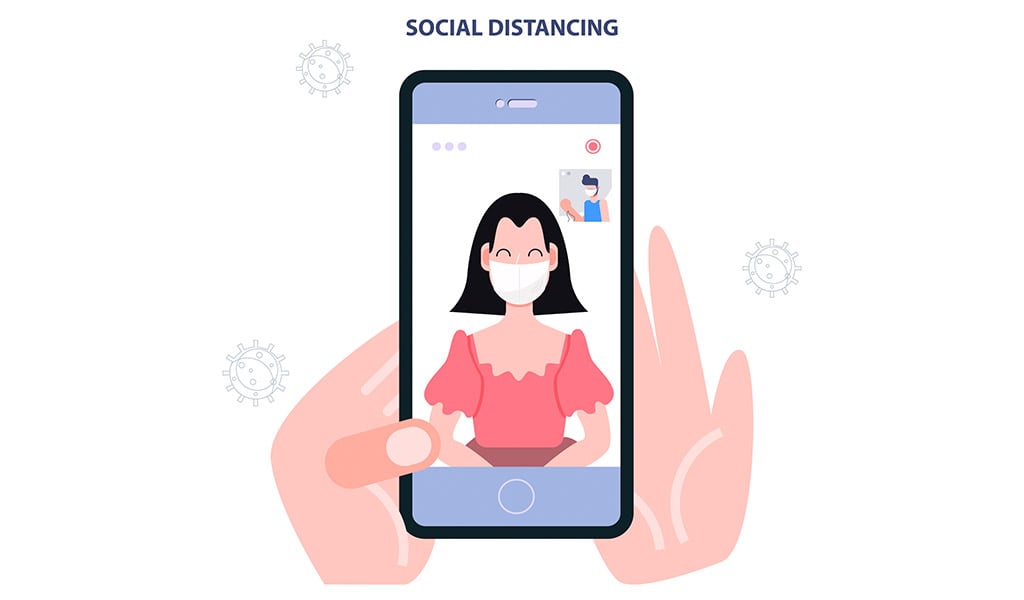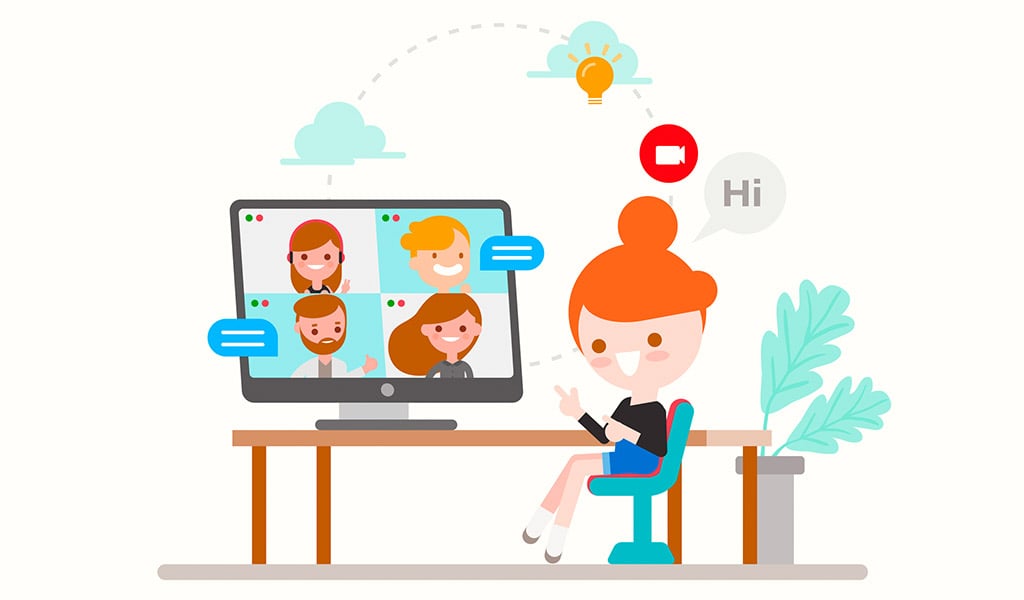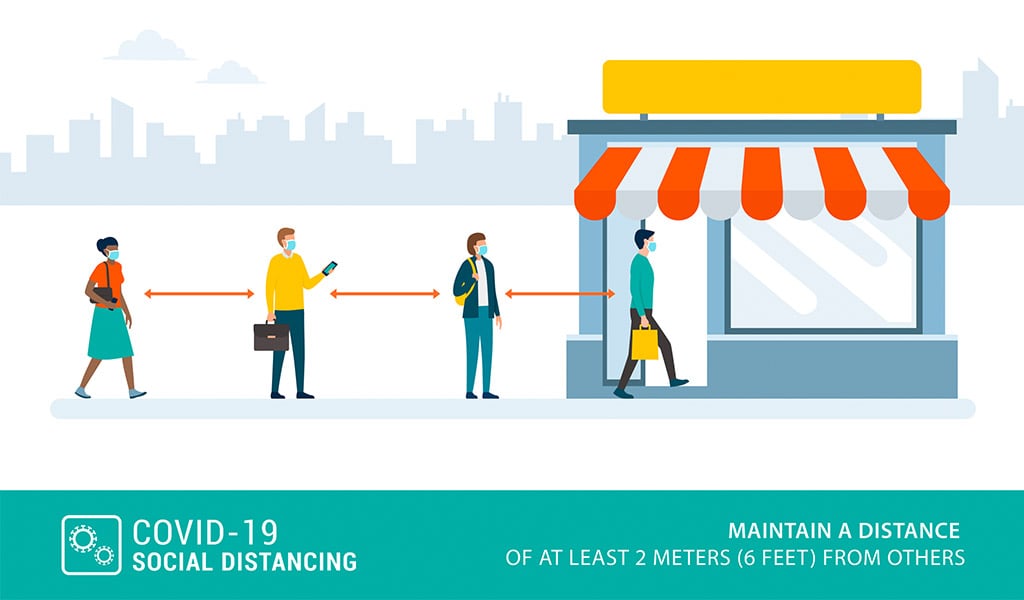
Making meaningful connections with your customers can be difficult even in the best of times. During a pandemic, it’s even harder. However, that doesn’t mean it’s impossible. In fact, there are lots of great ways you can continue to offer great customer service during this crisis. Let’s take a look.
What Exactly Is Social Distancing?
We think it’s important to address this because so many people have a different impression of what social distancing is. It’s also important to remind ourselves why it’s important. It’s only by understanding these two elements that we know how to properly serve our customers during this time.
Social distancing is also sometimes called “physical distancing” and is the act of keeping space between you and others outside of your household. Most experts have recommended that this space should be 6 feet (or 2 meters). This means you should always be 6 feet away from another person when in public unless that person is in your household. Avoiding gatherings or large groups is also an important element of social distancing. We do this by:
- Working from home to avoid offices.
- Closing schools (children are often called “super spreaders” of viruses because they spread the infection to other families through schools).
- Not visiting friends or family outside of your household. This is particularly crucial for vulnerable family members.
- Canceling or rescheduling events (Olympics, concerts, rallies, conferences, large meetings).
- Staying home and only infrequently visiting shops.
COVID-19 is spread through droplets that leave the mouth and nose when a person coughs, sneezes, or talks. These droplets can be inhaled by people in close proximity to an infected person. You can also get COVID-19 by touching surfaces with the virus on, and then touching your mouth, nose, or eyes (however, this is thought to be less common). It’s believed that a large percentage of people will be asymptomatic (present no virus symptoms). Asymptomatic carriers play a huge role in spreading the virus which is why social distancing is so important.
Talk to Your Customers
You can utilize chatbots and automation to handle the repetitive work and free agents up to talk to customers more deeply. You can also use your marketing team to keep in regular contact with your customers, so they are always up to date on what’s going on.
How to Connect with Your Customers
Talking to your customers is a form of customer experience management. It’s about developing a personal relationship with your customers, so they remember your business because of the positive emotions they felt during the interaction.
In the last decade, there has been a huge shift towards becoming more personable, informal, and friendly with customers. It just makes sense. Imagine a call center in a company that has a very impersonal and “corporate” style of speaking to their customers. If you walked around the call center agents coming in to start their workday saying “hey, you okay? Are you having a good day?” to their colleagues. Or chatting between calls about what they got up to at the weekend. Yet, when a call comes through, they immediately switch to a flat “This is [X business], How can we help?” with a dry and flat tone. This isn’t what customers want. You don’t have to talk to your customers the same way you would your best friend and start your calls with “Hey, man, what’s up?”. But equally, there is a middle ground where you can build a more personal connection.
Here’s how you connect with your customers like a friend:
- Give your immediate attention.
- Connection (finding common ground and encouraging positive emotions).
- Commitment (commit to solving their problem).
Each section can be broken down further. To give your attention you should be actively listening. This means you demonstrate to the customer that you’re following their issue. You can repeat parts of their query back to them to clarify their message. For connection, you can use friendly language, emojis, a positive tone, and empathize with their issue. For commitment, you must take responsibility for the problem and explicitly state how you will fix it.
Other Ways You Can Talk to Customers:
- Go live on social media
- Post to social media regularly and engage in conversations with your customers.
- Create customer surveys to find out how you can help them during the pandemic.

Communicate Your Plans for Social Distancing
If you deliver products to your customer’s door, then it’s paramount you follow social distancing guidelines. Delivery personnel should leave the package on the doorstep and then knock on the door and take a step back (6 feet) while they wait for the customer to answer. Your messaging must be consistent. If you are following social distancing for your office and supporting the measures on social media, then you must ensure they are followed by everyone representing your business.
It’s important to communicate with your customers on your plans for social distancing. Customers may be reluctant to buy from you if they aren’t sure whether your company is following these measures. The best way to increase their confidence in your brand is to clearly and directly communicate that you are prioritizing their safety.
Open Up Your Communication
During the pandemic, customers are more anxious and also have more time on their hands. This means they have more time to be anxious, but also more time to be proactive about the issues they face when it comes to the products and services they use. If your customers want or need to contact your company, then they shouldn’t struggle to do so in a way that makes sense to them. This means offering all communication channels.
Communication channels you should offer:
- Live Chat
- Chatbots
- Facebook and WhatsApp messaging
- Phone
- Contact forms
Not all customers are comfortable with calling, and the same is true for every communication channel. It’s also important to think about the positive effect each channel can have on your business. For example:
Live Chat: Agents can handle several chats at once. This isn’t possible with a call. Text data can also be analyzed to help improve the business.
Phone: Easy to build a rapport with customers and provide a positive customer experience.
Email: Text data can also be analyzed to help improve the business. Less urgent requests may go through email and reduce pressure on agents.
Contact forms: Text data can also be analyzed to help improve the business.
Chatbots: Reduce pressure on agents by immediately solving simple problems.
Facebook and WhatsApp Messaging: Provide a better customer experience by being where your customers are.
Offer Freebies and Incentives
Freebies and incentives are a great way to stimulate your revenue by encouraging more customers to take action. When consumers get a freebie, they experience positive emotions and are reminded of your company every time they see the product. This will encourage them to buy in the future. Incentives encourage action by removing buyer reservations. Maybe the customer was going to buy your product in the past but they decided not to due to the cost. Now the cost has been reduced, they are motivated to buy.
Freebies and incentives are even more powerful during the Coronavirus pandemic. Morale is low for many people. They are worried about their loved ones and their community. Money is also less certain. By offering freebies you can increase morale and bring a bit of joy to your customer’s day. With incentives, you can take some much needed financial pressure away from them but still give them access to the products that they want.
Here are some incentives you can offer:
- Extra rewards points: If you have a rewards points scheme, then you can increase the number of points your customers can earn by purchasing your products. Alternatively, you can reduce the amount products cost in your points currency.
- Offer an upgrade as a trial: If you have customers on your basic plan, you can offer to upgrade them for a limited trial period, for example, 2 weeks or 1 month. This way they can see the benefits of the extended version and decide whether it’s a good fit for them. At the end of the trial period, you can also offer the permanent upgrade at a discount.
- Discounts – Offer customers discounts on certain products or on their next purchase.
- Offer samples – If your customers are unsure which product to buy, you can offer samples to help them make a choice. Of course, this won’t work for all businesses and is better suited to inexpensive products.
Be Available Anytime
Use AI and automation to provide excellent customer service even when you are functioning at reduced capacity. Chatbots don’t get tired. They operate 24/7 and are there for customers whenever the customer needs them. Implementing a self-service knowledge base will also allow you to help your customers out of your operating hours. You could also consider implementing customer forums so your customers can connect with each other and share useful information.
Take Care of Your Employees
Your employees take care of your customers, and they are going through a stressful time too. For your employees to continue providing excellent customer experiences, they must be supported by the business. It’s important to be proactive about supporting your employees and enacting positive action wherever possible. Do this by:
- Clearly communicating your COVID-19 plans: Don’t let your employees worry about their job security. Their performance will go down if they feel unappreciated and at risk. Some employees may have to be furloughed or even lose their job altogether. The key is to be honest and direct about it so employees know what’s to come.
- Safe working conditions: If your employees are required to come into the office, then make sure the office space is safe. Ensure that everyone who can work from home is working from home. This will reduce the amount of people traffic and support social distancing.
- Share helpful advice with your employees: If you have advice on how to work effectively from home, how to structure your day, how to stay positive, then share it with your employees.
Happy employees lead to happy customers; you simply can’t have one without the other.

Support Your Community
Some larger businesses have donated money or medical supplies to areas in need. This might not be feasible for small businesses, but there are still ways you can help. Even something like sharing helpful community support programs going on in your local area can help connect your customers to the services they need.
Other Tips to Connect with Customers During Social Distancing
- Vary your communication – Don’t just rely on email. Not all of your customers will check their email every day. Instead, be everywhere! Send emails, post on Facebook and Twitter, update your LinkedIn.
- Encourage your customers to follow expert health advice – Do your bit to help flatten the curve and encourage your customers to act responsibly.
- Be warm – Be extra friendly, approachable, personable, and warm.
- Encourage customers to get in touch – Let them know you’re available and you’re happy to talk.